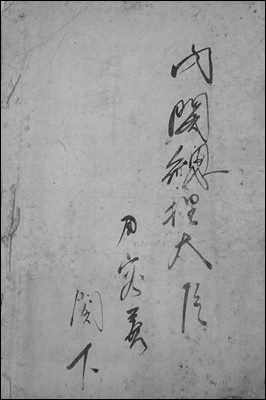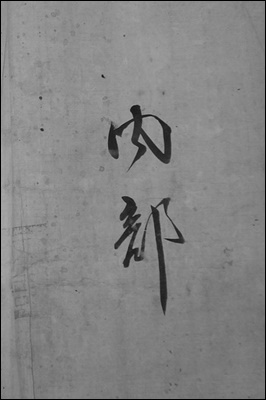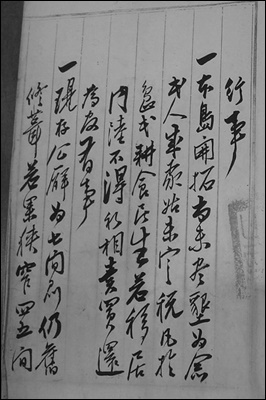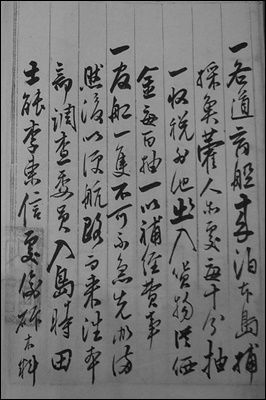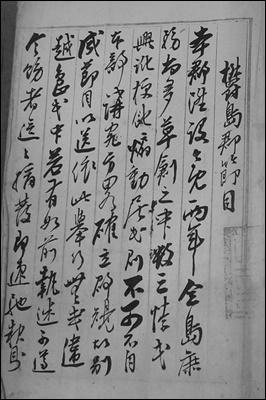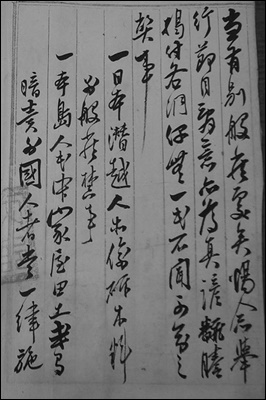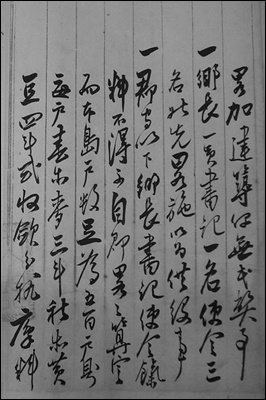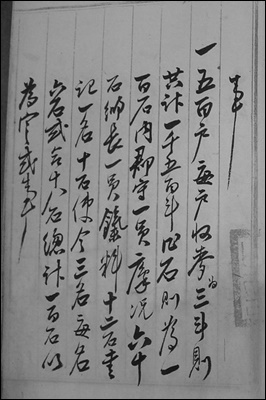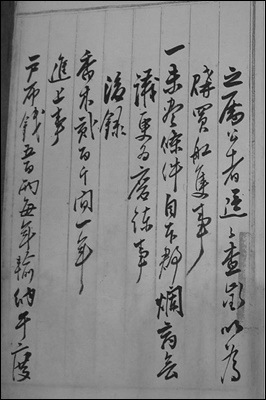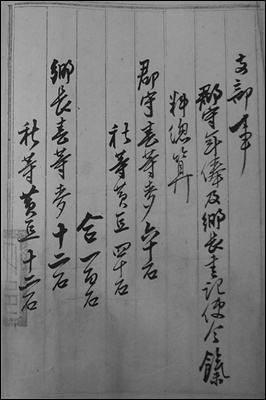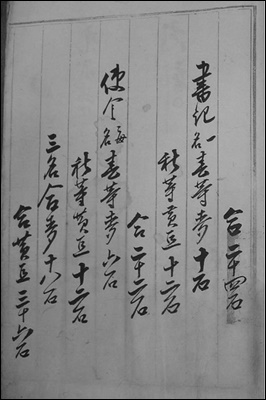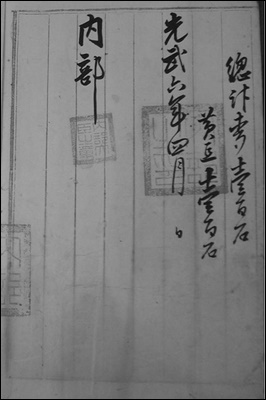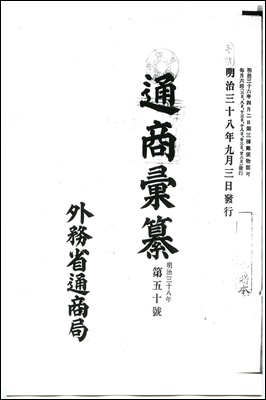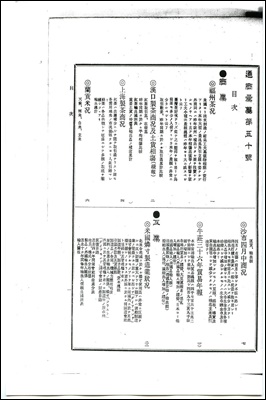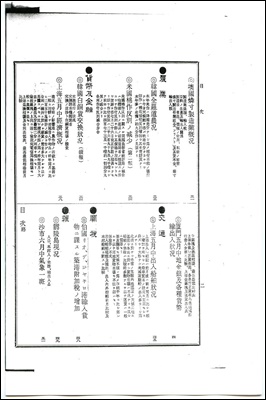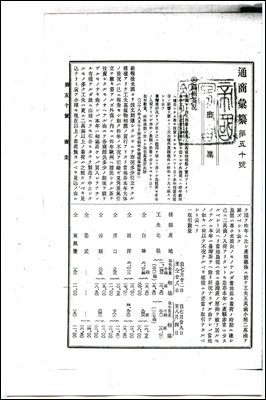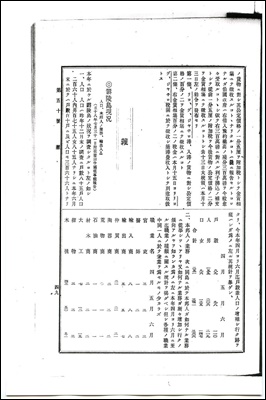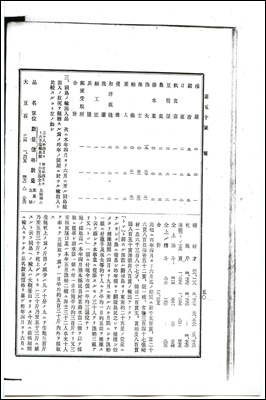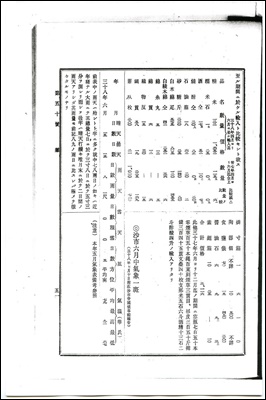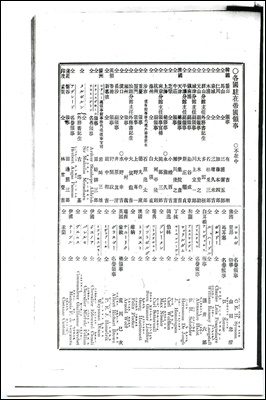 In 1902 the Uldo (Ulleung) Government lost its patience. Residents and Japanese trespassers were taking the natural resources of Ulleungdo without restraint. The local governor Bae Gye Ju (shown right) took action. Restrictions were put on those who lived or visited Ulleungdo. Most notably taxes were levied on those who caught fish in Ulleungdo and Dokdo’s waters.
In 1902 the Uldo (Ulleung) Government lost its patience. Residents and Japanese trespassers were taking the natural resources of Ulleungdo without restraint. The local governor Bae Gye Ju (shown right) took action. Restrictions were put on those who lived or visited Ulleungdo. Most notably taxes were levied on those who caught fish in Ulleungdo and Dokdo’s waters.
However, what do these records have to do with Dokdo? On their own, not much. But looking at the economic activity on Ulleungdo and how it was connected to Dokdo we can better understand the situation around 1900.
Below are images of the 1902 Ulleung Tax Laws, Hanja text and English translation. Further below are the Japanese Export Records for Ulleungdo and Dokdo in 1904. Finally there are records of fishing products harvested from Dokdo, later processed and exported from Korea’s Ulleungdo.
內閣總理大臣 尹容善 閣下
內部
鬱島郡節目
本郡陞設 今旣兩年 全島庶務 尙多草創之中 數三悖民 興訛梗化 煽動居民 則不可不自本部 講究方略
確立郡規 故別成節目 以送 依此擧行 無或違越 島民中若有如前執迷 不遵令飭者 這這摘發卽速馳報
則當有別般嚴處矣 惕念擧行節目辭意 亦爲眞諺飜謄 揭付各洞俾無一民不聞不知之弊事
一 日本潛越人等 偸斫木料 別般嚴禁事
一 本島人民中 家屋田土 或有暗賣外國人者 當一律施行事
一 本島開拓 尙未盡 懇爲念民人成家 姑未定稅 凡於島民耕食居生 若移居內陸 不得私相賣買 還爲官有事
一 現存公廨 爲七間 則仍舊修葺 若果狹窄四五間 略加建築 俾無民弊事
一 鄕長一員 書記一名 使令三名 姑先略施 以爲供役事
一 郡守以下 鄕長書記使令 餼料不得不自郡 略略算定 而本島戶數 足爲五百戶 則每戶春等 麥三斗 秋等黃豆四斗式 收斂分排廩料事
一 五百戶 每戶收麥爲三斗 則共計一千五百斗 凡石則爲一百石內 郡守一員廩況六十石 鄕長一員餼料十二石 書記一名十石 使令三名 每名六石式 合十八石 總計一百石 以爲定式事
一 各道商船來泊本島 捕採魚藿人等處 每十分抽一 收稅 外他出入貨物 從價金 每百抽一 以補經費事
一 官船一隻 不可不急先辦備 然後以便航路 而來往本部調査委員入島時 田士能李東信處 偸斫木料之屬公者 這這査徵 以爲購買船隻事
一 未盡條件 自本郡爛商會議 更爲磨鍊事
後錄
香木 貳百斤 間一年 進上事
戶布錢 五百兩 每年輸納于度支部事
郡守 年俸及鄕長書記使令餼料 總算
郡守 春等麥六十石 秋等黃豆四十石 合一百石
鄕長 春等麥十二石 秋等黃豆十二石 合二十四石
書記一名 春等麥十石 秋等黃豆十二石 合二十二石
使令每名 春等麥六石 秋等黃豆十二石 三名合麥十八石 合黃豆三十六石 總計麥一百石 黃豆一百石
光武六年四月 日
內部
Jeolmok (Guidelines) for Uldo-gun by the Ministry of the Interior
Two years have passed since the island in question(Uldo-gun) was promoted, and in the midst of their infancy state of general affairs across the island, there are the unenlightened who are creating groundless rumors and instigating others. Accordingly, the Ministry(the Ministry of the Interior) shall devise strategies and establish internal rules for Uldo-gun. The Ministry made separate regulations and sent them along. Abide by the rules as they are. Do not break them.
Residents who don’t follow the rules as before will be dealt with severely when reported promptly one by one as they get caught.
Pay special attention to it. Translate the meanings of the rules into plain Hangul(Korean) and post them in every village.
Make sure that there is no one who didn’t hear and don’t know about it.
– Impose a strict ban on specially those coming from Japan and cutting trees secretly
– Carry out an execution to those on the island who sell their house or land to foreigners secretly
– As the pioneering of the island has yet to settle and people are eager to have families, taxes won’t be decided yet. Let the islanders make a living by cultivating. However, if they migrate inland, prevent them from doing private transactions and let the properties be returned to the government.
– If the existing office has seven rooms, use it as it is with the roofs renovated. If it is a small size of four or five rooms, make small additions only. Do not make trouble for the residents.
– One 향장 (representative), one 서기(clerk) and three 사령(low-level officials) are to be assigned first for work.
– The county will have to do the rough calculations for salaries of chief, clerk, and officer including the county governor.
– Providing that there are at least 500 households on Ulleung Island, collect three mals of barley in the spring and four mals of beans in the fall from each household to pay for the salaries
.
– Three mals of barley from 500 households each makes 1500 mals in total. It is no more than100 in Sum. 60 sums for the governor, 12 sums for the representative, 10 sums for the clerk, and 6 sums for the 3 commanders each, which is 18 sums in total. Make the total 100 in Sum as a standard.
– Collect a tenth as a tax from each individual that comes to Ulleung Island as a merchant vessel from other provinces and catches fish. Charge a hundredth of the value of the goods to outbound cargoes to cover the expenses.
– A government vessel should have to be prepared to make the trips easier. When an investigator from the Ministry visits the island, have him thoroughly look into the case that Jeonsa Neung(전사능) and Doghshin Lee(이동신) made the secretly sold lumber returned to the government. Have him charge taxes and use the money to fund the purchase cost of the ship.
– The Ministry will discuss enough to make arrangements for insufficient conditions.
Postscript
200 Geuns of juniper are to be presented(tributed?) annually.
500 nyang (currency) of Hopojeon shall be paid to 탁지부(government office or ministry) every year.
Salaries of the governor and those of 향장, 서기, and 사령 shall be all summed up.
For the governor, 60 sums (sum=unit of measurement) of barley in the spring, 40 sums of beans in the fall. To sum up, 100 sums in total
For 향장, 12 sums of barley in the spring, 12 sums of beans in the fall, 24 sums in total
For 서기, 10 sums of barley in the spring, 12 sums of beans in the fall, 22 sums in total
For each 사령, 6 sums of barley in the spring, 12 sums of beans in the fall. For three 사령s, 18 sums of barley in total, 36 sums of beans in total.
To sum up, 100 sums of barley and 100 sums of beans in total.
April, 6th Year of Gwangmu(1902), the Ministry of the Interior
Population, Business of Japanese, Items of import /export
(The report by consul at Pusan, 31st July, 1905)
Section 1 – Population
There were 85 households and 260(175.male and 85-female) people in the December of last year report. The number increased to 110 households and 366 population this June. The stats below show how the number increased from April to June.
April ,May ,June
Households 89, 98, 110
Male 155, 206, 219
Female 96, 135, 147
Sum 251, 341, 366
Section 2 – Business of Japanese
Next, the stats for the variety of occupation from April to June below show what kind of business Japanese are getting engaged or what kind of business are increasing. Note: not a small number of people engage in two or more businesses for one person.
Business April, May, June
Officials 3, 3, 3
Doctor 1, 2 ,2
Importer 8, 8, 8
Exporter 5, 5, 7
Broker 21, 21, 21
Dealer in China 2, 2, 2
Dealer in household goods 0, 1, 1
Oil dealer 1, 1, 1
Lumber dealer 2, 2, 2
Carpenter 7, 12, 12
Joiner 3, 3, 3
Sawyer 43, 50, 52
Cooper 0, 0, 1
Blacksmith 5, 5, 5
Day labourer 2, 2, 2
Restaurant 1, 1, 1
Tofu maker 2, 2, 2
Farmer 2, 3, 3
Diver(潜水業) 0, 0, 2
Fishermen 15, 27, 31
Diver(海士) 0, 32, 32
Sailor 0, 31, 31
Employee 2, 2, 2
Servant 2, 1, 1
Dressmaker 2, 2, 2
Laundry 1, 1, 1
Handiworker 1, 1, 1
Charcoal burner 1, 1, 1
Post office 1, 1, 1
Sum
Section 3 – The items of import / export
Next is the number to show the situation of the import/export in comparison between this year and around the same period last year.
export in 4-6, 1905 export in 4-6, 1904
Items unit Quantity, Price, Quantity, Comparison
Soy beans Koku(石) 214 / 1,605 / 470 / △256
Zelkova trees lumber Sai(才) 62,118 / 3,727 / 38,382 / 23,726
Dried abalone Kin(斤) 4,770 / 4,770 / — / 4,770
Sea lion skins Kan(貫) 1,275 / 1,275 / 800 / 475
Sea lion oils To(斗) 414 / 538 / 20 / 394
Sea lion lees To(斗) 800 / 160 / — / 800
Sum 12,075
Addition to that, there were exports of 1,500 Kan(貫) of firewood, 26 Kan and 800 Me(目=匁) mushrooms、52 Kan laver, 1 barrel of ●, 347 Hyou(俵) of Salt, 16,387 Sai of Japanese hemlock lumber, 200 Kan of Korean coins, 800 Kan of Phellodendron, 850 Kan of dried squid and 800 Kan of Sealion meat.
The Sealion called “トド(Todo)” lives on the island called “Lanko”(Dokdo) which is located about South east of 25-ri from Ulleungdo. From around last year, the residents of Ulleungdo(鬱陵島民) started to hunt them. The hunting season is 6 months from April to September. It is said that around ten hunters or seamen on one fishing ship catch 5 sea lions on average in one day. Thus, there are about 30 people with 3 sets of fishing boats who engage in this business. The market price of the sea lion is 3 Yen(円) per one sea lion on average.
As for the haul of abalone, Yoshimura of Kumamoto(熊本) pref. engaged in diving with 2 diving equipment, and the catch was 300 Kin(斤) of fresh abalone per one diving gear on average. Another man, Hamaguti of Mie(三重) pref. lead 32 divers(海士) and 10 sailors on 2 fishing boats and engaged in gathering abalones. The amount of abalone was more or less than 530 Kin per one day on average. Fresh abalone reduced in their weight when they are dried, So the reduction of Kin was almost 9/10. It is said that 300-530 kin of fresh water dried into 30-53 Kin.
The export from this island is to Pusan in most cases. Now, below is the import statistics of the goods this year (items, numbers and price) to show the comparison with the data of April to June last year.
Import 4-6, 1905 Import 4-6, 1904
Item Quantity Price Quantity Comparison
Polished rice 122 / 1,652 / 470 / △256
Glutinous rice 1 / 25 / 0 / 0
Sake 17 / 52 / 10 / 7
Shochu 20 / 83 / 0 / 20
Oil 18 / 63 / 20 / 2
Sugar 220 / 25 / 140 / 80
White Cotton 575 / 805 / 120 / 455
Twill weave cotton 42 / 252 / 36 / 6
Cotton thread / 5 / 12 / — / 5
Cotton / 6 / 12 / — / 6
Fabric(textiles) 15 / 30 / — / 15
Iron 58 / 19 / 225 / 169
Cigar 280 / 21 / 1,010 / 780
Match 1 / 6 / 1 / 0
China unknown / 10 / 500 / unknown
Salt 70 / 15 / 450 / 380
Soy source 6 / 9 / 9 / 3
Vermicelli 10 / 25 / — / 10
Sum 3,116
Addition to this, during the period from June to December in 1904, there were 750 vacant bottles, 750 cigarette, 150 ropes, 100 bundle of tobaccos 350 Kin of Japanese cedar barks, 345 Kanmon(貫文) of Korean coins, 40 Tatamis, 5 Koku 6 To of Chinese rice, 13 Koku 2 To of Sake lees and 4 Shou of Acetic acid for the import.
Japanese abalone fishing on Dokdo is repeatedly mentioned in many Japanese records. Abalone would have definitely been taxed as a fishing product by Governor Bae Gye Ju. Prior to 1902, Governor Bae had lived on Ulleungdo for over 20 years, and had even voyaged to Matsue, Japan for a lengthy period. He was also ambitious and hoped to make profit from Ulleungdo’s abundant lumber. Bae Gye Ju was well liked by Japanese on Ulleungdo.
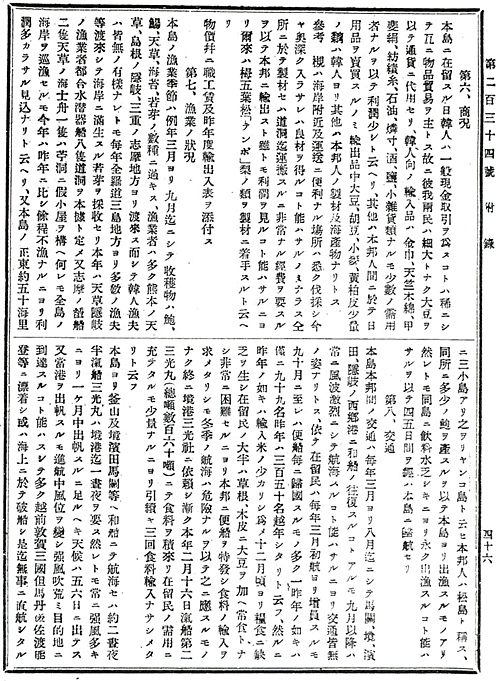 In 1902 it was recorded fishermen were catching abalone on Dokdo. As mentioned incoming merchant and fishing vessels from other regions were required to pay tax. The 1904 Tax Records mention abalone were processed and dried on Ulleungdo, as there was no fresh water nor facilities on Dokdo. This would have taken place almost certainly at Dodong Port were most Japanese resided.
In 1902 it was recorded fishermen were catching abalone on Dokdo. As mentioned incoming merchant and fishing vessels from other regions were required to pay tax. The 1904 Tax Records mention abalone were processed and dried on Ulleungdo, as there was no fresh water nor facilities on Dokdo. This would have taken place almost certainly at Dodong Port were most Japanese resided.
Bae Gye Ju spoke fluent Japanese and lived amongst the Japanese community at Dodong, Ulleungdo. He moved to Ulleungdo in 1881. He was also quite ambitious and would have not passed up the chance to tax those involved in fishing. Below is the relevant text from the 1902 report detailing Japanese activity on Dokdo.
“…Also, about fifty nautical ri due east from the island, (Ulleungdo) there are three small islands called “Ryanko-do” (Liancourt Rocks), which Japanese residents call Matsushima. There is abalone on the island, so some fishermen go there. However, drinking water on the island is scarce, so it is impossible to fish there for long periods. They come back to this island (Ulleungdo) after four or five days there…”
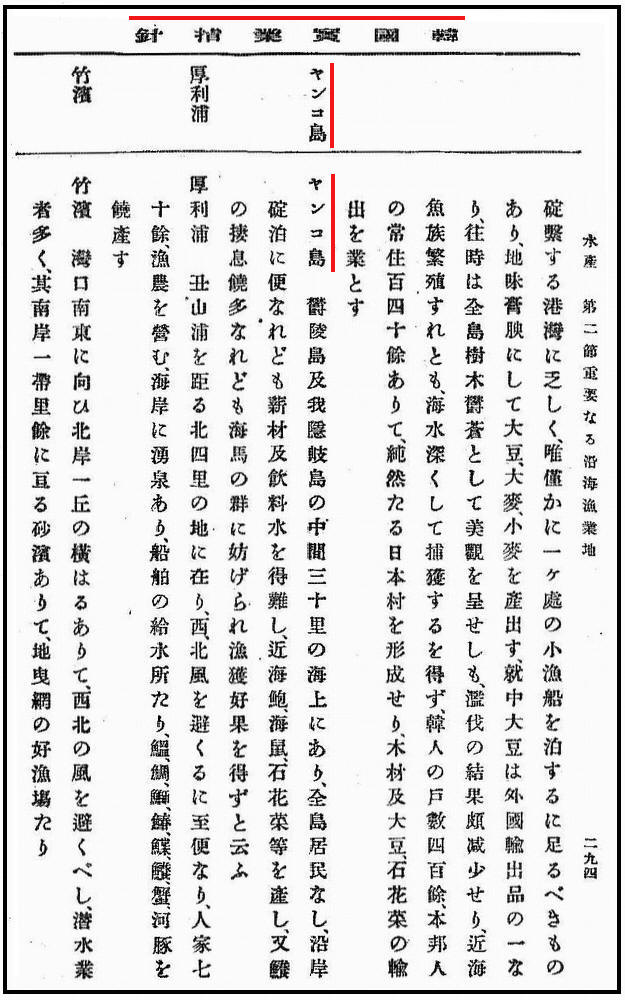 In 1904 this guide was published for the purpose of informing Japanese nationals the nature of doing business in Korea. Within this publication was a section about business (fishing etc.) in Kangwan Province. Here again, another document proving Japanese were harvesting taxable marine products from Dokdo.
In 1904 this guide was published for the purpose of informing Japanese nationals the nature of doing business in Korea. Within this publication was a section about business (fishing etc.) in Kangwan Province. Here again, another document proving Japanese were harvesting taxable marine products from Dokdo.
“…Yankodo (Liancourt Rocks – Dokdo) Yankodo is in the center between Ulleungdo and Japan’s Oki Island at a distance of about 30ri. Even if mooring is available offshore, it’s difficult to find firewood and drinking water.Abalone, sea cucumber, agar-agar can be harvested offshore. Even though many sharks inhabit the waters, many can’t be caught because of the sealions in the area…”
 In 1903 the ultra-nationalist group Black Dragon’s Fishing Guide recorded Japanese caught abalone on Dokdo. Below describes the harvesting of abalone on Dokdo by Japanese.
In 1903 the ultra-nationalist group Black Dragon’s Fishing Guide recorded Japanese caught abalone on Dokdo. Below describes the harvesting of abalone on Dokdo by Japanese.
“…The relevant text is as follows:
“…About 30-ri south-east of Ulleungdo, and almost the same distance north-west from Japan’s Oki county, there is an uninhabited island. One can see it from the highest point of 山峯 (Seong-In Mountain) on Ulleungdo when the weather is fine.
Korean and Japanese fishermen call it “Yanko”,(Liancourt Rocks – Dokdo) its length is about 10-cho. Its coast is full of bends and twists, thus, it’s easy for fishing boats to be in anchor and to escape winds and waves. However, it is very difficult to get firewood and drinking water, one can dig the ground for several shaku (1.0 – 1.5meters) from the surface but hard to get water.
There is an abundance of sea lions that live on the island and the area around the island has many abalone, sea cucumber and agar…”
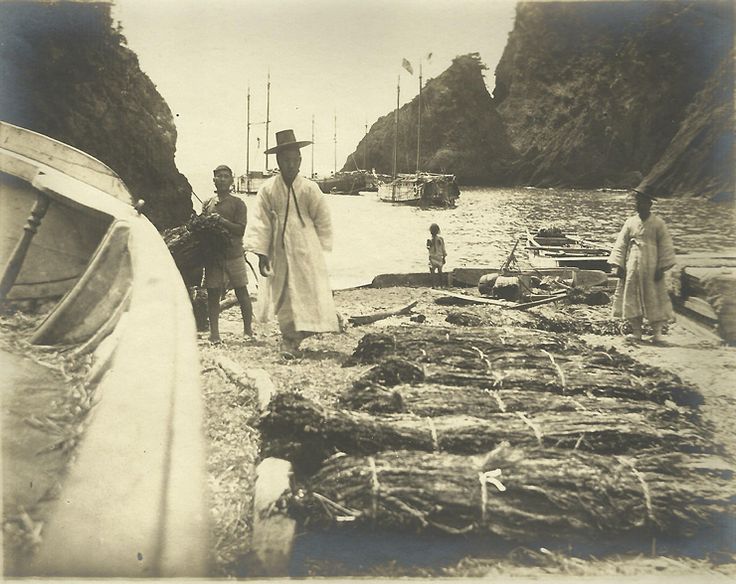 Because of Dokdo’s lack of potable water, absence of processing facilities, and remote location, a base on Korea’s Ulleungdo was imperative. At this time, refrigeration was non-existent. Abalone would need to be processed and dried for preservation.
Because of Dokdo’s lack of potable water, absence of processing facilities, and remote location, a base on Korea’s Ulleungdo was imperative. At this time, refrigeration was non-existent. Abalone would need to be processed and dried for preservation.
Almost all Japanese fishermen on Ulleungdo lived at Dodong Harbor. Unfortunately, for them, imports and exports were monitored at Dodong by Korea. In fact, there was also an organization of Japanese citizens at Dodong, who required incoming Japanese vessels submit a manifest of goods upon arrival. Any arriving ships with incoming or outgoing products would not escape taxation in such a small port. Those who arrived with goods subject to taxes, would have to pay.
Thus, it’s only logical to conclude Japanese who harvested marine resources from Dokdo such as abalone and sea cucumber would have been taxed when returning to their bases at Dodong, Ulleungdo. Image to the right shows Koreans exporting goods from Dodong Port Ulleung Island in 1906. (from Robert Neff collection)
This explains why a transient Japanese fisherman living in Saigo, Oki Islands first approached the Korean government to lease Dokdo Island. Nakai Yozaburo fished for sea cucumber all over, from Vladivostok Russia, Korea’s South Cholla, and Chung Cheong Provinces and other areas. Although Nakai also referenced sea charts for territorial ownership, he also knew all activity on Dokdo went through Korea’s Ulleungdo.
By 1903 Nakai must have known Koreans Officials levied taxes on Dokdo’s marine products. He most likely believed Dokdo was Korean because the Ulleungdo Government exercised a degree of effective control over Dokdo through taxation of Ulleungdo region’s marine resources.

